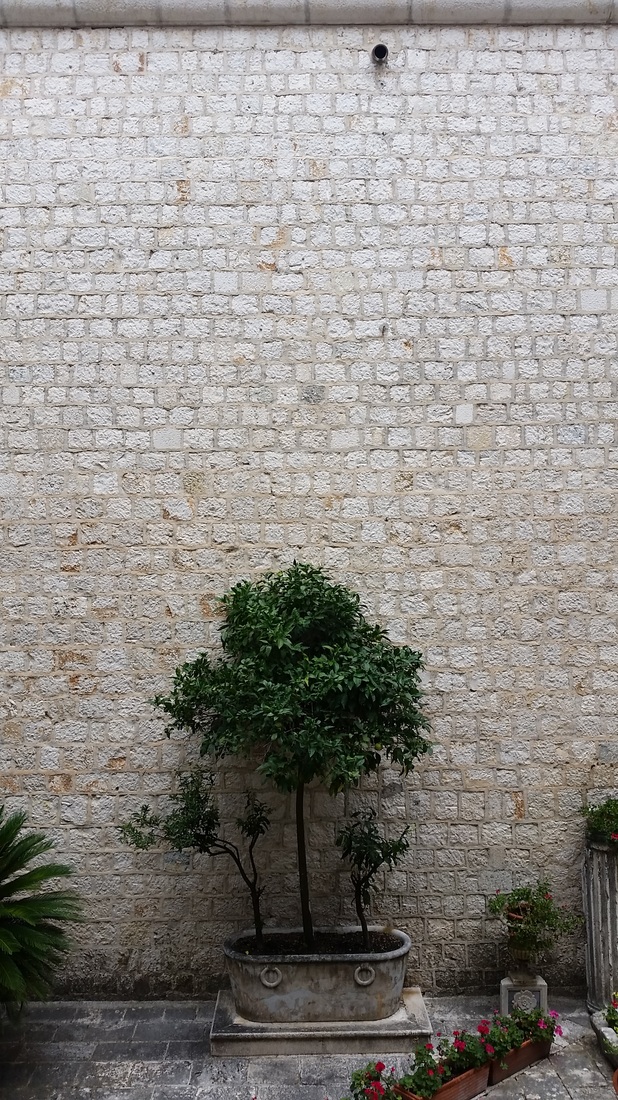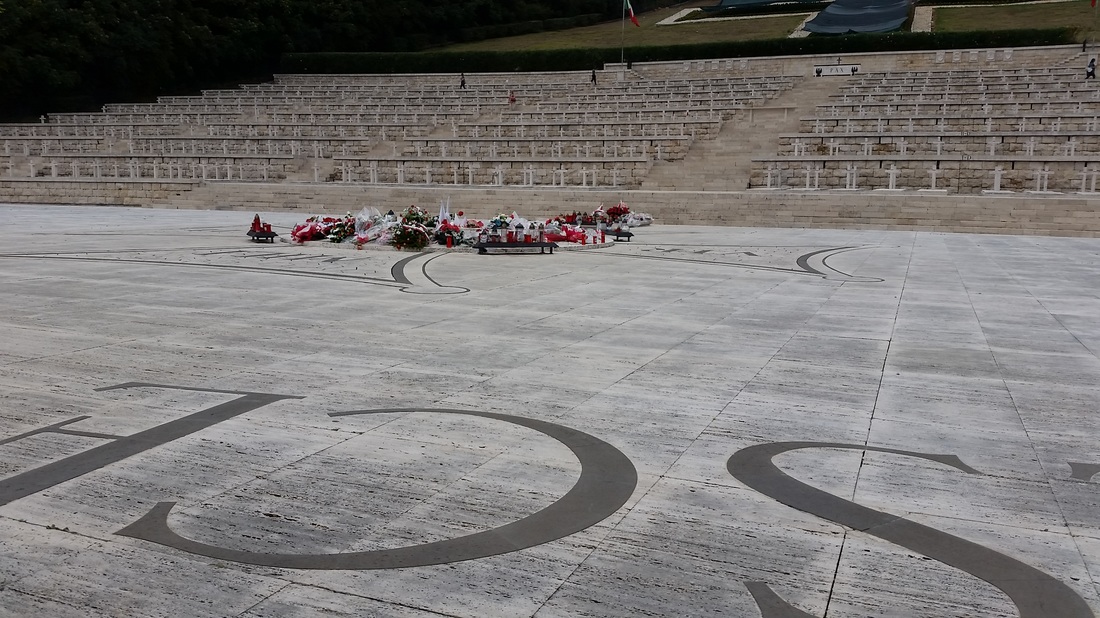|
A southern wedding
A recent family wedding took us south from Verona, first on the high speed Frecciargento to Rome, and then on the decidedly more sedate Regionale line that links Rome and Napoli by way of Cassino. Our final destination was Vairano-Caianello, a small settlement in the province of Caserta, where the wedding ceremony itself would take place. But, with a free day before the festivities kicked-off, we decided to return to Cassino to visit its famous monastery. About 130 kilometres southeast of Rome, the monastery at Cassino (Montecassino) stands on a prominent rocky hill some 520 metres high. Here in about 529, on the site of a pre-existing Roman fortification, Benedict of Nursia founded the monastic order that would bear his name and which would become the blueprint for Western monasticism. His remains still lie beneath the high altar of the basilica at Montecassino.
A seat of contemplation and learning
In the years following its foundation, the abbey became well known as a place of pilgrimage, a revered centre of culture and learning, amassing an incredible collection of art, religious artefacts and holy relics. In particular, during the medieval period, the school of manuscript illuminators and the documents they produced in the monastery's revered scriptorium were renowned throughout the world. Although a great seat of learning, culture and art, the monastery has also endured some dark times. Its prominent position to the south of Rome has long made it a site of strategic importance. Indeed, during the Second World War, Allied General Harold Alexander called it "one of the strongest natural defensive positions in the whole of Europe".
War, terror and destruction
Back in 577, the monastery was destroyed by the Lombards, a Germanic people who ruled large parts of the Italian Peninsula from 568 to 774. In 883 it was again invaded and sacked, this time by the Saracens, who killed Bertharius the monastery's influential abbot (now venerated as saint and martyr San Bertario di Montecassino). Then, having enjoyed a long period of peace and prosperity, on 9th September 1349, the abbey was again severely damaged, this time by a catastrophic earthquake. This devastating event marked the beginning of a period of decline for the abbey. In 1799, at the dawn of the a new era, Napoleon's army once again brought death and destruction to the monastery at Montecassino. It was during the Second World War, though, that the monastery faced its most profound threat when, for a few devastating months, the abbey found itself on the front line of this most deadly and destructive of conflicts.
Saving the treasure
The Gustav Line, which crossed Italy from the Tyrrhenian sea in the west to the Adriatic coast in the east, was one of three German defensive lines that were intended to prevent the Allied troops from advancing any further north into Italy and, above all, to protect Rome and the southern route through Europe's soft underbelly into the Nazi hinterland. Although German troops had been specifically ordered not to use the abbey for military purposes, to the Allied forces below it appeared that the monastery was in fact a key stronghold in defensive system. In the winter of 1943, with the battle looming, a number of like-minded German officers conspired to save the abbey's priceless treasures. In a remarkable operation (described in some detail in Robert M. Edsle's thrilling book Saving Italy), they somehow managed to relocate the abbey's collection to two Benedictine monasteries in Rome. With war raging all around, it was a Herculean task. As well as the abbey's own treasures, priceless works of art from Naples, as well as irreplaceable manuscript codices and the collections of the Keats-Shelley Memorial House in Rome, had been sent to the archives at Montecassino for safekeeping. The Nazi hierarchy was aware of treasure and parts of the collection had been earmarked to join Göering's personal collection. By November 1943, one hundred fully loaded trucks had transported the Abbey's treasure to the secret storage facility. Its contents had been saved, but what fate awaited the Abbey itself?
The first assault
The Battle of Montecassino began on 17 January 1944. In fact, the battle was actually 4 separate offensives. The combination of impregnable terrain, resolute German defence and a particularly cold and wet winter meant that this was one of the most brutal battles of the war. In the Liri Valley bellow the monastery, the Germans had smashed dikes and diverted water courses to flood large parts of the valley floor, making it virtually impassable to Allied tanks and trucks. The road to Rome was blocked. The first assault on Montecassino, from 17-24 January 1944, was, in fact, a diversionary blow intended to draw German reserves from the main amphibious attack on Anzio which was launched on 22 January. Although it may have succeeded in this objective, Allied commanders failed to exploit the initial breakthrough and a combination of intense German resistance, inadequate planning and a lack of armoured support led to appalling casualty figures, particularly amongst the U.S. 36th Infantry Division (Texas) which suffered 80% losses (143 dead, 663 wounded and 875 missing in just 48 hours).
The second assault
With U.S. VI Corps under intense pressure at Anzio, the Second Battle of Montecassino (from 15 to 18 February) was intended to divert the German forces and relieve some of that pressure. Despite Eisenhower's directive "to respect those monuments so far as war allows", there was a growing military belief that in order to break through the Gustav Line, the abbey had to be destroyed. Whether the monastery itself represented a credible military objective remains a point of much controversy. Indeed, it has since been described as the equivalent of Italians bombing Westminster Abbey. Ultimately though, the order was given and, on 15 February 1944, waves of Allied bombers (229 in total) dropped 493.5 tons of high explosives and incendiaries. The main causalities of this bombardment, however, were not German soldiers, but the refugees who were sheltering inside. The Abbot and six monks, who had hidden in the deepest vaults of the abbey, emerged to discover only a pile of rubble where once the ancient monastery had stood. The bombardment did not, however, break the stalemate. On the night after the bombing, a company of the 1st Battalion, Royal Sussex Regiment (serving in 7th Indian Infantry Brigade) attacked Monastery Hill from their position 70 yards (64 m) away on Snakeshead Ridge. The company suffered 50% casualties and the assault failed. A further assault followed the next night and again the Royal Sussex Regiment suffered devastating losses. In the two-day assault they lost 12 out of 15 officers and 162 out of 313 men who took part in the attack. Subsequent assaults by the Rajputana Rifles of India, the Gurkha's of Nepal and New Zealand Māori brigades suffered similar fates. The second assault had failed.
The third assault
The Third Battle of Montecassino was again to be preceded by a heavy artillery bombardment, but while waiting for the adequate weather conditions that would enable the preliminary bombing, the assault was postponed on 21 successive days. Meanwhile, the troops waited in the freezing conditions for the green light to battle. It finally came on 15 March 1944. Success depended on efficacy of the aerial bombardment. However, the shelling had not been as effective as had been hoped, and the German defences rallied more quickly than expected. The weather turned and torrents of rain flooded bomb craters, turning rubble into mud and drenching radio sets, preventing effective communication. Despite the problems, the New Zealanders captured Castle Hill and the Indians took Hangman's Hill, a strategic highpoint just below the monastery, which the Gurkhas then bravely held. The Allied forces had come within 250 yards of the Monastery. But, on 22 March, after repeated unsuccessful assaults had met with resolute defence and with the troops of the New Zealand Divisions exhausted, the Allied offensive was again called off.
The final assault and breakthrough
On 11 May 1944, the moment the Poles had been waiting for for so long had finally arrived. After the failure of three previous Allied offensives, the daunting task now fell to the II Polish Corps. Their country had suffered more than most at the hands of the Nazis and it was, perhaps, their desire for revenge and retribution that inspired them where others had previously failed. The fourth assault on Montecassino was part of a wider multinational offensive along the Gustav Line (Operation DIADEM). French, Moroccans, Algerians, Canadians, New Zealanders, Nepalese, Indians, South Africans, Australians, Rhodesians, as well as Brits, Americans and Poles, formed an immense army of more than a quarter of a million men. Elaborate deception plans had been effective, and the Germans were not expecting a major attack at this time. It was to be the biggest battle of the war so far. It was hoped that the sheer volume of attackers would saturate the German defences and enable the crucial breakthrough. Improved weather, ground conditions and supply would also be important factors. Canadian I Corps were to be held in reserve ready to exploit the anticipated breakthrough. Again the assault was preceded by a massive artillery bombardment. Monte Calvario (Point 593 on Snakeshead Ridge) was taken by the Poles only to be quickly recaptured by German paratroopers. For three days Polish attacks and German counter-attacks brought heavy losses to both sides. Polish II Corps lost 281 officers and 3,503 other ranks in assaults before the attacks were eventually called off. In the early morning hours of 12 May, the Polish infantry divisions were met with "such devastating mortar, artillery and small-arms fire that the leading battalions were all but wiped out." Below the Monastery, the town of Cassino had been completely destroyed. Not a single building remained. By the third week in May the Germans were in full retreat. At last the much anticipated breakthrough had arrived. But instead of finishing off the retreating Germans, Clark chose instead to strike for Rome, preferring his place in history to finishing off the job at Montecassino. The German 10th Army escaped to fight another day and, although the Gustav Line had finally been broken, the hard-won Battle of Cassino was a costly and somewhat hollow victory.
Restoration and recovery
Remarkably the abbey has been restored to it's former glory. I'm not sure what I was expecting, but I was somewhat overwhelmed by the sheer scale and ostentatiousness of it. The vast collection of artefacts on display was breathtaking. Gold from the dark ages, 10th century remains of the original marble floor, priceless wooden statuettes, lavishly bound books, manuscripts and drawings dating from the 6th century, holy vestments, ivory and religious iconography. A statue of St. Benedict, the monastery's founder, dating from 1736 somehow survived more or less intact. Quite what he would have made of it all is beyond me. Although time didn't allow us to explore as much of the area as I would have liked, we did have the chance to visit the Polish War Cemetery where the remains of more than 1000 Polish soldiers lie. A white marble obelisk bears the words: "For our freedom and yours, we soldiers of Poland gave our soul to God our life to the soil of Italy our hearts to Poland." And as for the wedding, it was a fairy-tale affair: a beautiful bride, extravagant southern hospitality and food and drink in abundance. I'm already looking forward to the next family reunion in a couple of years time. Another trip to the tragic battlefields of Montecassino might not wait that long. |
AboutRichard Hough writes about history, football, wine, whisky, culture + travel and is currently working on a trilogy about wartime Verona.
|













